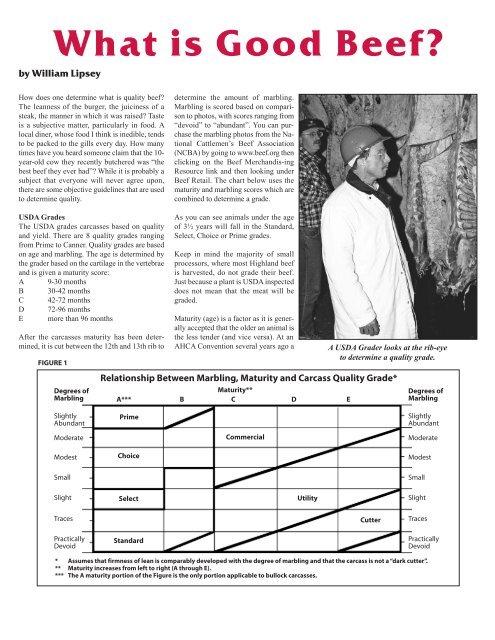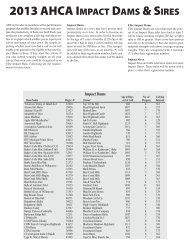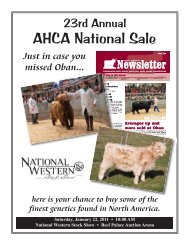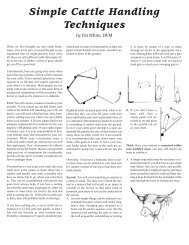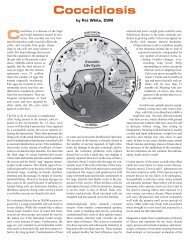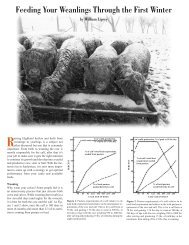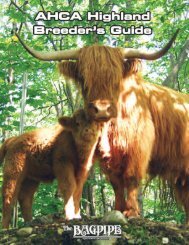What is Good Beef? - American Highland Cattle Association
What is Good Beef? - American Highland Cattle Association
What is Good Beef? - American Highland Cattle Association
Create successful ePaper yourself
Turn your PDF publications into a flip-book with our unique Google optimized e-Paper software.
<strong>What</strong> <strong>is</strong> <strong>Good</strong> <strong>Beef</strong>?<br />
by William Lipsey<br />
How does one determine what <strong>is</strong> quality beef?<br />
The leanness of the burger, the juiciness of a<br />
steak, the manner in which it was ra<strong>is</strong>ed? Taste<br />
<strong>is</strong> a subjective matter, particularly in food. A<br />
local diner, whose food I think <strong>is</strong> inedible, tends<br />
to be packed to the gills every day. How many<br />
times have you heard someone claim that the 10-<br />
year-old cow they recently butchered was “the<br />
best beef they ever had”? While it <strong>is</strong> probably a<br />
subject that everyone will never agree upon,<br />
there are some objective guidelines that are used<br />
to determine quality.<br />
determine the amount of marbling.<br />
Marbling <strong>is</strong> scored based on compar<strong>is</strong>on<br />
to photos, with scores ranging from<br />
“devoid” to “abundant”. You can purchase<br />
the marbling photos from the National<br />
<strong>Cattle</strong>men’s <strong>Beef</strong> <strong>Association</strong><br />
(NCBA) by going to www.beef.org then<br />
clicking on the <strong>Beef</strong> Merchand<strong>is</strong>-ing<br />
Resource link and then looking under<br />
<strong>Beef</strong> Retail. The chart below uses the<br />
maturity and marbling scores which are<br />
combined to determine a grade.<br />
USDA Grades<br />
The USDA grades carcasses based on quality<br />
and yield. There are 8 quality grades ranging<br />
from Prime to Canner. Quality grades are based<br />
on age and marbling. The age <strong>is</strong> determined by<br />
the grader based on the cartilage in the vertebrae<br />
and <strong>is</strong> given a maturity score:<br />
A 9-30 months<br />
B 30-42 months<br />
C 42-72 months<br />
D 72-96 months<br />
E more than 96 months<br />
After the carcasses maturity has been determined,<br />
it <strong>is</strong> cut between the 12th and 13th rib to<br />
FIGURE 1<br />
Degrees of<br />
Marbling<br />
As you can see animals under the age<br />
of 3½ years will fall in the Standard,<br />
Select, Choice or Prime grades.<br />
Keep in mind the majority of small<br />
processors, where most <strong>Highland</strong> beef<br />
<strong>is</strong> harvested, do not grade their beef.<br />
Just because a plant <strong>is</strong> USDA inspected<br />
does not mean that the meat will be<br />
graded.<br />
Maturity (age) <strong>is</strong> a factor as it <strong>is</strong> generally<br />
accepted that the older an animal <strong>is</strong><br />
the less tender (and vice versa). At an<br />
AHCA Convention several years ago a<br />
A USDA Grader looks at the rib-eye<br />
to determine a quality grade.<br />
Relationship Between Marbling, Maturity and Carcass Quality Grade*<br />
Maturity**<br />
A*** B C D E<br />
Degrees of<br />
Marbling<br />
Slightly<br />
Abundant<br />
Prime<br />
Slightly<br />
Abundant<br />
Moderate<br />
Commercial<br />
Moderate<br />
Modest<br />
Choice<br />
Modest<br />
Small<br />
Small<br />
Slight<br />
Select<br />
Utility<br />
Slight<br />
Traces<br />
Cutter<br />
Traces<br />
Practically<br />
Devoid<br />
Standard<br />
Practically<br />
Devoid<br />
* Assumes that firmness of lean <strong>is</strong> comparably developed with the degree of marbling and that the carcass <strong>is</strong> not a “dark cutter”.<br />
** Maturity increases from left to right (A through E).<br />
*** The A maturity portion of the Figure <strong>is</strong> the only portion applicable to bullock carcasses.
AHCA Convention several years ago a professor<br />
from M<strong>is</strong>souri presented h<strong>is</strong> thes<strong>is</strong> that the industry<br />
should not worry so much about fin<strong>is</strong>hing<br />
the animals but instead to harvest them younger<br />
as age <strong>is</strong> the main factor in tenderness. The<br />
counter to that <strong>is</strong> that age also affects flavor –<br />
the older the more flavor. Think of veal, which<br />
<strong>is</strong> basically very young beef and has very little<br />
“beef” flavor. Many feel that because most animals<br />
today are put directly into feedlots after<br />
weaning and fin<strong>is</strong>hed at 11-14 months of age,<br />
beef in the stores <strong>is</strong> less flavorful. Generally it <strong>is</strong><br />
considered that 36-40 months of age <strong>is</strong> the maximum<br />
age for acceptable tenderness.<br />
Marbling <strong>is</strong> a measure of the intramuscular fat in<br />
the rib area. Marbling <strong>is</strong> the main factor used to<br />
determine quality – with Prime having the most<br />
amount of marbling and <strong>is</strong> considered the best<br />
quality beef. Marbling will increase the juiciness<br />
of the meat and generally increases the tenderness<br />
and eating quality. Many studies have been<br />
done that show as the amount of marbling<br />
(higher grade) increases, consumer d<strong>is</strong>sat<strong>is</strong>faction<br />
decreases. Th<strong>is</strong> does not mean that a lower<br />
quality grade (less marbling) will not produce a<br />
sat<strong>is</strong>factory piece of meat.<br />
Tenderness<br />
Another obvious major factor in the enjoyment<br />
of beef <strong>is</strong> tenderness. Tenderness varies by cut,<br />
a general rule of thumb <strong>is</strong> the muscles that are<br />
used the most (in the rear - round and the front –<br />
chuck) are less tender and those used the least<br />
(the rib and the loin area) are more tender. Cooking<br />
methods can improve the tenderness of a<br />
particular cut – properly cooked a chuck roast<br />
will melt in your mouth – but some cuts are expected<br />
to “perform” under any method. People<br />
want to be able to throw a 1½ inch thick rib-eye<br />
steak onto the grill and no matter how well done,<br />
it should be tender and tasty. The only objective<br />
test available for tenderness <strong>is</strong> the Warner-Bratzler<br />
test, which <strong>is</strong> not often practical for a small<br />
producer. There are DNA tests for tenderness but<br />
the accuracy of those are questionable. There are<br />
a few things you can do as a producer to help<br />
ensure your product <strong>is</strong> as tender as possible:<br />
• Proper and quiet handling. A nervous stressed<br />
out animal will produce less tender beef.<br />
• Eliminate poor d<strong>is</strong>position animals. Study<br />
after study has shown that animals with poor<br />
temperaments grow slower and produce<br />
tougher meat. If you have an animal with a<br />
particularly poor d<strong>is</strong>position you would be<br />
better off selling it early or using it for ground<br />
beef only.<br />
• Consider 36 months as the maximum age for<br />
harvesting. Older animals will be tougher.<br />
• Dry age your beef.<br />
Dry Aging<br />
Most commercial beef in the US <strong>is</strong> slaughtered<br />
one day and cut up (either into primals or consumer<br />
cuts) the next. It <strong>is</strong> then bagged with<br />
gasses that extend the shelf life – most packers<br />
guarantee freshness for 60 days – and shipped<br />
to the stores. Any aging of the beef <strong>is</strong> done in<br />
the bags and <strong>is</strong> called “wet aging”. Aging increases<br />
tenderness and most industry experts<br />
will ins<strong>is</strong>t that wet aging <strong>is</strong> every bit as effective<br />
in increasing tenderness as dry aging. Most beef<br />
produced by <strong>Highland</strong> breeders and harvested<br />
by small plants <strong>is</strong> dry aged. Typically the carcasses<br />
are hung in a cooler for a week to 4 weeks<br />
before they are cut up. Dry aging increases tenderness<br />
and most importantly flavor. Probably<br />
one of the most common comments that small<br />
producers hear about their beef <strong>is</strong> how much<br />
more flavor it has, how it tastes like beef used<br />
to. The hanging or the aging of the carcass <strong>is</strong><br />
probably the biggest factor. There <strong>is</strong> a reason top<br />
steakhouses around the country invest in aging<br />
rooms to dry age their steaks before serving<br />
them. Flavor! Note the original Quality <strong>Highland</strong><br />
<strong>Beef</strong> guidelines required an aging period of<br />
14-21 days. Th<strong>is</strong> <strong>is</strong> the small producers “ace in<br />
the hole” that can really help d<strong>is</strong>tingu<strong>is</strong>h their<br />
beef from the average sold in the store.<br />
So ultimately, what <strong>is</strong> good beef? Or better yet,<br />
what kind of animal will produce good beef? In<br />
general, a steer or heifer that <strong>is</strong> harvested between<br />
12-36 months of age, that has at least a slight<br />
amount or more of marbling and has been hung<br />
for at least two weeks.


